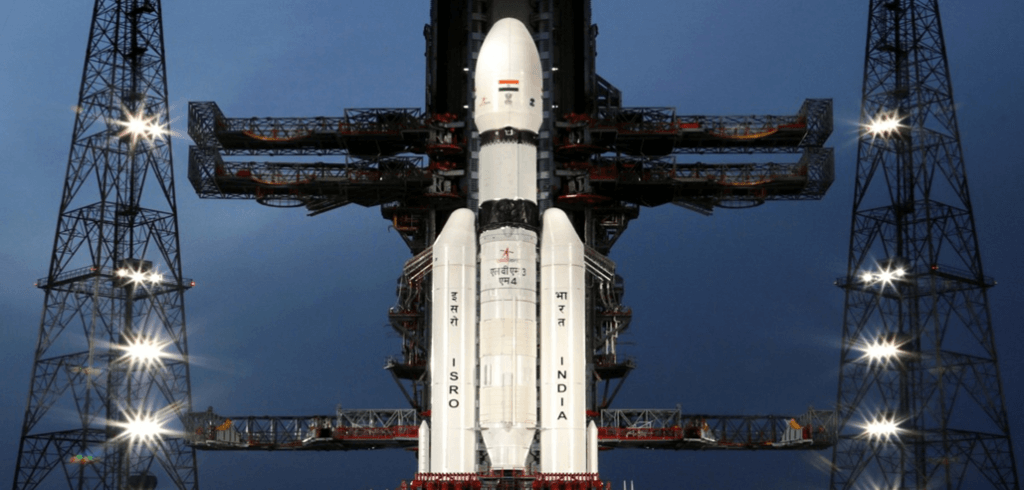Daily Current Affairs : 11-July-2023
Chandrayaan-3 is an upcoming space mission that will mark the next chapter in India’s lunar exploration program. It is the successor to the Chandrayaan-1 and Chandrayaan-2 missions. One of the key objectives of Chandrayaan-3 is to become the first spacecraft to land on the Moon’s South Pole, an area that remains unexplored by humans. In this essay, we will delve into the details of Chandrayaan-3 and the significance of its mission to the lunar South Pole.

Chandrayaan-3 Mission:
Chandrayaan-3 is primarily focused on landing and roving activities, as opposed to its predecessor, Chandrayaan-2, which had an orbiter component. The mission aims to demonstrate safe and soft landing on the lunar surface and showcase the capabilities of a rover to traverse the Moon’s terrain. Additionally, Chandrayaan-3 will conduct in-situ scientific experiments to gather valuable data about the lunar environment.
Components of Chandrayaan-3:
The mission comprises three key components: the Lander module (LM), the Propulsion module (PM), and the Rover. These components have been designed to develop and demonstrate new technologies necessary for future interplanetary missions. The Lander module is equipped with the ability to perform a soft landing at a predetermined lunar site. It will then deploy the Rover, which will carry out in-situ chemical analysis of the lunar surface as it moves across its designated area.

Importance of the Lunar South Pole:
The choice of the Moon’s South Pole as the landing site for Chandrayaan-3 holds great significance. The lunar south pole is the southernmost point on the Moon, located at 90°S. It is a region where water ice has been detected in permanently shadowed areas. This discovery opens up exciting possibilities for future human exploration and colonization efforts. The water ice found in these shadowed regions can potentially be extracted and used as a valuable resource for supporting long-duration lunar missions.
Craters and Cold Traps:
The lunar south pole region is characterized by craters that have a unique property – they are permanently shadowed. These craters act as “cold traps” where sunlight never reaches their interiors. Consequently, these cold traps preserve a record of the early Solar System, containing hydrogen, water ice, and other volatile substances. By exploring these craters and studying their contents, scientists can gain insights into the history and evolution of the Moon and the wider solar system.
Important Points:
- Chandrayaan-3 is the successor to Chandrayaan-1 and -2, marking India’s next lunar exploration mission.
- It aims to be the first spacecraft to land on the Moon’s South Pole, an unexplored region by humans.
- Chandrayaan-3 focuses on landing and roving activities, without an orbiter element like Chandrayaan-2.
- Mission objectives include safe and soft landing, rover mobility, and in-situ scientific experiments.
- Components of Chandrayaan-3 include the Lander module, Propulsion module, and Rover, showcasing new interplanetary technologies.
- The lunar South Pole has water ice in permanently shadowed areas, making it an important target for exploration.
- Craters at the South Pole act as cold traps, preserving records of early Solar System substances like hydrogen and water ice.
- Chandrayaan-3’s mission contributes to understanding the Moon’s history and evolution.
- Exploring the lunar South Pole has implications for future lunar missions and potential resource utilization.
Why In News
Chandrayaan-3 is poised to make history as the first lunar lander to touch down on the unexplored terrain of the Moon’s enigmatic South Pole. Armed with cutting-edge technology and scientific instruments, this mission aims to unlock the secrets hidden in this uncharted region, paving the way for future lunar exploration endeavors.
MCQs about Chandrayaan-3
-
What is the primary objective of Chandrayaan-3?
A. To explore the Moon’s North Pole.
B. To demonstrate safe landing and rover mobility on the lunar surface.
C. To study the Martian atmosphere.
D. To search for signs of life on the Moon.
-
Which component is missing in Chandrayaan-3 compared to Chandrayaan-2?
A. Lander module
B. Propulsion module
C. Orbiter module
D. Rover
-
What makes the lunar South Pole an important target for exploration?
A. It has the highest mountain on the Moon.
B. It contains vast amounts of precious minerals.
C. Water ice is found in permanently shadowed areas.
D. It is closest to Earth, making communication easier.
-
What does the term “cold traps” refer to in the context of the Moon’s South Pole?
A. Regions with extreme temperature fluctuations.
B. Craters that preserve a record of the early Solar System’s volatile substances.
C. Dark areas on the lunar surface.
D. High-altitude regions with thin atmosphere.
Boost up your confidence by appearing our Weekly Current Affairs Multiple Choice Questions
![]()


